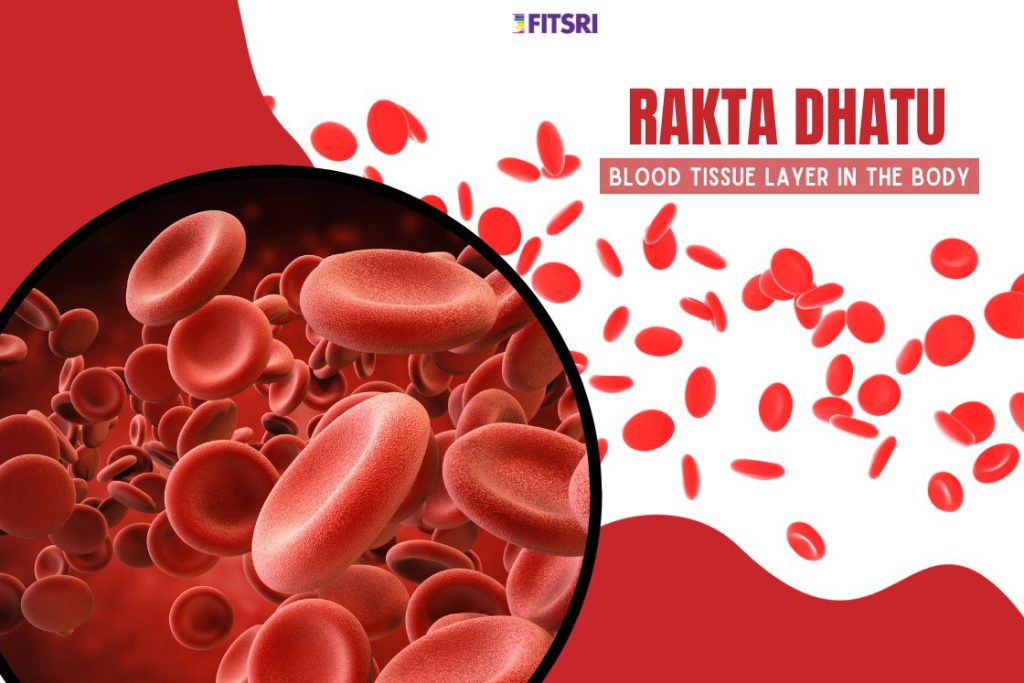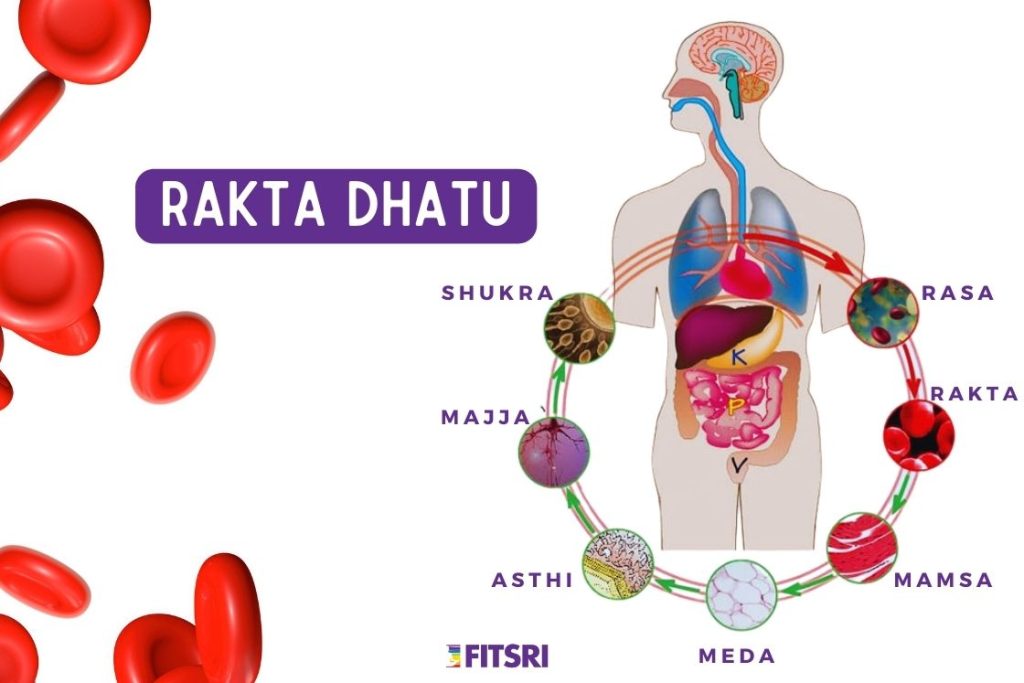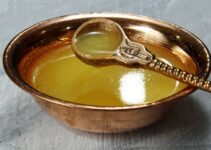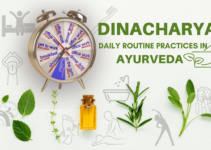
Dhatus in Ayurveda represents for the primary tissues that form the building blocks of our body. They not only provide structure, but also perform the essential physiological functions that keep us alive and healthy. When immersed in the essence of Ayurveda, the study of the Dhatus becomes essential. They provide continuous nourishment, growth and repair of the body and form the foundation upon which our holistic health stands.
There are Seven Primary Dhatus in Ayurveda:
- Rasa (Plasma)
- Rakta (Blood)
- Mamsa (Muscle)
- Meda (Fat)
- Asthi (Bone)
- Majja (Bone marrow and nervous tissue)
- Shukra (Reproductive tissue)
In the light of modern science, one can find fascinating parallels between the Dhatus in Ayurveda and today’s understanding of human physiology. For example, when Ayurveda speaks of the “Rakta” Dhatu, it refers to the blood tissue that modern medicine recognises as responsible for transporting nutrients and oxygen. Similarly, the “Mamsa” Dhatu corresponds to our muscles, which are essential for movement and stability.
There is a fascinating harmony at the interface between ancient Ayurvedic principles and modern medical knowledge. Although terminologies and methods differ, both approaches aim to understand the intricacies of the human body. The Dhatus in Ayurveda, with their profound meaning, can be seen as early intuitive insights into what contemporary science describes in detailed physiological terms.
What is Rakta Dhatu in Ayurveda?

At its core, Rakta Dhatu is the Sanskrit term for the blood tissue of the body. Rakta” translates to “red” or “blood”,” and “Dhatu” means “tissue” or “that which supports” Rakta Dhatu thus represents the essence of our blood tissue, which circulates throughout the body and plays an essential role in nourishing cells, transporting essential nutrients, and promoting overall vitality.
In Ayurveda, however, Rakta dhatu is not just about the physical blood that flows through our veins. It is a more holistic concept. In Ayurvedic philosophy, Rakta Dhatu ranks second among the seven primary tissues (Dhatus) in our body, indicating its role in absorbing nutrients from the first tissue and then nourishing subsequent tissues.
Also Read: Rasa Dhatu: First Tissue Layer in Ayurveda
Looking at the Blood Tissue Through the Scope of Ayurveda
While modern science sees blood primarily in the context of circulation and the transport of oxygen and nutrients, Ayurveda views the Dakta dhatu as a more fundamental life force that has tasks beyond mere circulation.
While blood simply refers to the physiological components like RBC, WBC, Platelets, and so on, Rakta Dhatu in Ayurveda extends to components responsible for interactions between blood, the lymphatic system, and the endocrine system.
While modern sciences consider immunity, temperature regulation, and waste elimination as systems separate from the circulatory (or blood) system, Ayurveda sees the basic units of immunity, temperature regulation, and toxin elimination as components of Rakta Dhatu. In short, Rakta Dhatu in Ayurveda is a much broader and more inclusive category compared to the modern understanding of blood.
Moreover, Ayurveda does not separate physiology from its energetic capacity as modern science does. For example, modern science defines the physiology of a molecule independently of the energy that changes its state. Energy is energy, a separate force that must be studied and investigated, and that acts on physiology to bring about change.
In Ayurveda, however, physiology and energy are intertwined, as if together they form a single functional unit. Thus, in Ayurveda, the dhatus are not only the physiological tissues, but also the energies associated with those tissues.
It is fair to point out that there is no right or wrong between Ayurveda and modern science. Both use a similar, yet uniquely different systematic approach to categorize the same biological reality of our bodies.
What did Sushruta and Chakrapani Say About Rakta Dhatu?
The wisdom of Ayurveda and its holistic healing systems has been shaped and enriched by numerous sages and scholars over the centuries. Two such monumental figures are Sushruta and Chakrapani. Their insights into Rakta Dhatu in Ayurveda provide a deep understanding that is still relevant.
Sushruta’s Perspective on Rakta Dhatu:
Sushruta described in detail the physiology, properties and functions of Rakta Dhatu in his seminal work “Sushruta Samhita”. He described it as a primary life-sustaining force closely related to prana (life force). Sushruta highlighted the following points:
- Formation: He described the process of its formation from the essence of the food we consume, with the liver and spleen as the primary sites for its production and storage.
- Qualities: Rakta Dhatu, as described by Sushruta, possesses attributes like warmth and redness. It is this warmth that helps maintain the body’s internal temperature.
- Functions: Beyond transportation, he acknowledged its role in providing nourishment, sustaining life, and supporting the mind and consciousness. An imbalance in Rakta Dhatu could impact these vital functions.
- Disorders: Sushruta also outlined various diseases and disorders arising from the vitiation of Rakta Dhatu. For instance, skin disorders, bleeding conditions, and inflammation were associated with its imbalance.
Chakrapani’s Insights into Rakta Dhatu:
Chakrapani further elaborated on the qualities and properties of Rakta Dhatu in Ayurveda. He described its inherent qualities and emphasized its cool, sweet and fluid nature. For Chakrapani, the main function of Rakta dhatu was to nourish the body, supporting life and vitality. He also discussed possible diseases that can arise when Rakta Dhatu becomes contaminated and suggested therapeutic measures to restore its balance.
The Physiology of Rakta Dhatu
How is Rakta Dhatu Formed in Our Body?
- Initial Digestion and Nutrient Extraction: The food we consume is broken down in our digestive system, by Agni the digestive fire. From this digestion, a nutritive essence called “Ahara Rasa” is derived.
- Transformation into Rasa Dhatu: The first product of the ingested food’s digestion is “Rasa Dhatu,” akin to plasma in modern terms. This nutrient-rich component forms the baseline for subsequent tissue formations. This essence serves as the foundation for Rakta Dhatu formation, illustrating the direct link between the quality of our food intake and the vitality of Rakta Dhatu in Ayurveda.
- Rakta Dhatu Emergence: Rasa Dhatu, under the influence of the “Ranjaka Pitta“ (a specific biological fire or energy), undergoes a transformation in the liver and spleen. This metamorphosis results in the formation of Rakta Dhatu. The importance of the liver and spleen in this process is emphasized both in Ayurveda and modern physiology, marking a significant correlation.
- Five-Day Cycle: According to Ayurvedic texts, from the ingestion of food to the formation of refined Rakta Dhatu, it takes a span of five days. This timeline underscores the methodical and gradual transformation process.
- Link with Modern Understanding: When we examine Rakta Dhatu in Ayurveda, its formation can be paralleled with the production and maturation of blood cells in modern hematopoiesis. Both recognize the critical role of nutrition and a series of biological processes in ensuring the vitality of blood.
By grasping the nuances of Rakta Dhatu’s formation, we appreciate the emphasis Rakta Dhatu in Ayurveda places on nutrition, digestion, and the interconnectedness of bodily processes. Ayurvedic systems not only highlight the body’s profound ability to regenerate and sustain but also underscore the vitality of every dietary choice we make.
What is Rakta Dhatu Made Up of?
The composition of Rakta Dhatu according to Ayurvedic understanding can be broken down by the following categorizations:
- Essential Nature: Rakta Dhatu is primarily associated with the element of fire, albeit in a balanced and nourishing form. This association is indicative of its vital roles – distributing heat, supporting metabolism, and carrying oxygen.
- Primary Components: The primary constituents of Rakta Dhatu in Ayurveda are the red blood cells. These cells are responsible for oxygen transport, which aligns with modern medicine’s understanding of the red blood cells’ role in carrying oxygen to various parts of the body.
- Supportive Elements: While the red blood cells are the primary component, Rakta Dhatu also encompasses other elements that support its primary function. These might include nutrients, hormones, and enzymes. Together, they ensure the vitality and nourishment of the body’s tissues.
- Relation to Doshas: Rakta Dhatu is closely related to the Pitta Dosha, the bio-energy governing metabolism, heat, and transformation. An imbalance in Rakta can often be traced back to a Pitta imbalance, leading to conditions such as inflammation or skin issues.
What are the Qualities of Rakta Dhatu?
Compiling the various references across the Ayurvedic literature, Rakta Dhatu can be understood to have the following qualities under the Ayurvedic framework:
- Sasneha (Slightly Oily): One of the intrinsic qualities of Rakta Dhatu is being slightly oily. This characteristic ensures smooth circulation and lubrication within the body’s channels, facilitating seamless transportation of nutrients and oxygen to various tissues.
- Ushna (Warm): Rakta Dhatu possesses a warm quality. This warmth is vital for metabolic processes, aiding in the digestion of food and maintaining the body’s internal temperature.
- Drava (Liquid) and Sara (Fluid): Being liquid and fluid are fundamental to Rakta Dhatu’s nature. These states allow it to flow through the circulatory system, ensuring every cell gets the nutrients it needs.
- Laghu (Light): Rakta Dhatu is light, which means it can circulate swiftly, ensuring timely delivery of nutrients and removal of waste products.
- Visra (Foul Smelling): When Rakta Dhatu is imbalanced or vitiated, it can develop a foul smell. This quality is a diagnostic tool in Ayurveda, indicating potential issues or imbalances within the body.
The Ayurvedic Relation Between Rakta and Agni
Ayurveda often employs nature-derived concepts to elucidate its principles. One such foundational notion is the correlation between blood and fire. This relationship underscores the pivotal role of Rakta Dhatu in Ayurveda in maintaining balance and ensuring the body’s vitality.
- Fire as a Transformative Force: In Ayurveda, fire symbolizes transformation and change. It’s not just about the literal flame; it’s the essence that drives change. Modern sciences echo this idea, defining energy as the capacity to instigate change, whether it’s moving an object or facilitating a chemical reaction within our cells.
- Introduction to Biologic Fire: Moving from the external world to the intricate processes within our bodies, we encounter the concept of biological fire. This isn’t the fire you see, but the transformative energy or “Agni” in Ayurveda. It’s the force that powers our metabolic reactions, breaks down food, and generates warmth.
- Biologic Fire and Rakta Metabolism: Rakta Dhatu, our primary focus, plays an integral role in this transformative process. The metabolism of Rakta Dhatu in Ayurveda is driven by a specific biological fire known as “Ranjaka Pitta.” Situated in the liver and spleen, Ranjaka Pitta oversees the conversion of nutrient essence from digested food into mature Rakta Dhatu.
- Rakta’s Role in Maintaining Body’s Fire: Once Rakta Dhatu is formed and infused with this energy, it doesn’t just stay static. Through circulation, Rakta Dhatu distributes this fire or energy, maintaining the body’s overall warmth, fueling cellular activities, and ensuring the smooth functioning of organs. Think of it as a distributive network, ensuring every corner of our body remains invigorated.
Ayurveda Vs Modern Science: The Differences in Understanding the Blood tissue
Understanding the body’s fundamental elements is key in both Ayurveda and modern medicine. Rakta Dhatu in Ayurveda and blood in modern medicine appear to describe the same thing. However, delve deeper and you’ll see the prominent differences in their approaches.
1. The Composition of Blood Tissue
- Ayurvedic Perspective: Rakta Dhatu in Ayurveda embodies the essence of life and vitality. Although it circulates nutrients, Rakta Dhatu’s essence is deeply spiritual, connected with the body’s very life force. Ayurveda recognizes Rakta to be made up of elements like the biological fire, the transformed “Rasa” and a fundamental entity that attributes the color red. The fundamental entity that contributes to the color can be considered as the RBC.
- Modern Perspective: Blood, in modern science, is a tangible fluid comprised of red and white blood cells, platelets, and plasma. Its components have specific tasks, from oxygen transport (thanks to hemoglobin in red blood cells) to immune defense (attributed to white blood cells).
2. Formation
- Ayurvedic Perspective: The formation of Rakta Dhatu is a fascinating process rooted in the body’s digestive function. When we consume food, it’s transformed into a juice called “Ahara Rasa.” This juice undergoes further refinement, resulting in the creation of each Dhatu, with Rakta Dhatu being one of them.
- Modern Perspective: Blood cell formation, or hematopoiesis, occurs in the bone marrow. Stem cells present here differentiate into various blood cells. The process is influenced by several factors, including certain hormones and body needs.
3. Sites of Action
- Ayurvedic Perspective: Rakta Dhatu in Ayurveda operates in specific bodily channels known as “Srotas.” These channels distribute nutrition and maintain various physiological functions. The liver and spleen, in particular, are vital sites for Rakta Dhatu’s actions, including production and storage.
- Modern Perspective: Blood operates through the cardiovascular system, comprising the heart, veins, arteries, and capillaries. This system ensures that oxygen, nutrients, and hormones reach every cell, and waste products are efficiently removed. The liver and spleen play a very important role in cleansing and maintaining the quality of the blood, but not really the site of production or storage.
Why is Rakta Red? Similarities in Ayurveda and Modern Science
In the field of Ayurveda, the red color of the Rakta Dhatu is closely associated with the Pitta Dosha, which is supported by the elemental forces of fire and water. On closer examination, it’s the Ranjaka Pitta subtype of this Dosha that gives the blood its characteristic red color. This fiery dimension of Pitta, reflecting the transformative power of fire, is central to the vitality and vibrancy of our blood.
Viewed through the eyes of modern science, our blood owes its crimson color to red blood cells (RBCs). These cells are teeming with hemoglobin, an important protein that ensures oxygen travels from the lungs to every corner of our bodies. The science behind the color is fascinating: when hemoglobin binds oxygen, it creates oxyhemoglobin, which emits a bright red glow. If, on the other hand, this bond is broken and the oxygen escapes, what remains is deoxyhemoglobin, which takes on a dusky, dark red, almost blueish tint.
Bridging these perspectives, Ranjaka Pitta from the “Rakta Dhatu in Ayurveda” narrative can be analogized with modern scientific phenomena. It bears semblance to the metabolic vigor that propels hemoglobin to clinch oxygen molecules, or it might even be perceived as a reflection of the nature of hemoglobin itself. Through this blend of ancient wisdom and contemporary knowledge, we gain a richer, more holistic understanding of the essence of our blood.
The Integral Role of a Healthy Rakta Dhatu in Our Well-being
The concept of Rakta Dhatu is central in Ayurvedic teachings, acting as a cornerstone of our physical health. When this vital tissue is in balance, it brings forth a myriad of benefits, contributing substantially to our overall well-being. So, how exactly does a healthy Rakta Dhatu influence our state of health? Let’s explore:
- Vigorous Circulation: A healthy Rakta Dhatu ensures efficient circulation throughout the body. This means oxygen and essential nutrients are delivered effectively to every cell, fostering vitality and energy. It’s like having a well-oiled machine, where every part functions optimally.
- Toxin-free Body: Rakta Dhatu in Ayurveda plays a pivotal role in detoxification. When healthy, it efficiently transports waste products away from cells, leading to a body that’s purged of toxins. The result? Enhanced body functions and a reduced risk of diseases.
- Robust Immunity: A balanced Rakta Dhatu is akin to a shield. It fortifies our immune system, making us resistant to infections and illnesses. When our defense mechanism is strong, we can fend off external invaders with ease, ensuring longer, healthier lives.
- Mental Clarity: Rakta Dhatu doesn’t only benefit our physical state. Adequate oxygen and nutrient supply, courtesy of a healthy Rakta Dhatu, lead to better brain function. This translates to clearer thought processes, improved focus, and enhanced cognitive abilities.
- Harmonious Balance: Rakta Dhatu in Ayurveda is also about maintaining equilibrium. A healthy Rakta Dhatu supports other tissues, ensuring a harmonious balance of all bodily functions. This interconnectedness paves the way for a state of comprehensive well-being.
Identifying the Symptoms of Unhealthy Rakta Dhatu: Signs of Visuddha Raktawan Purusha
The harmony of our body, as elucidated in the principles of Rakta Dhatu in Ayurveda, can be disrupted when this essential tissue becomes impure or unhealthy. This condition is termed as “Visuddha Raktawan Purusha” in Ayurvedic terminology. Recognizing the symptoms associated with unhealthy Rakta Dhatu is crucial for timely intervention and restoration of balance. So, what are these indicators that one should be alert about?
- Skin Abnormalities: The first tell-tale sign of impure Rakta Dhatu is evident on the skin. Conditions such as acne, rashes, eczema, or an unnatural pallor can suggest that all isn’t well with the Rakta Dhatu.
- Inflammatory Disorders: Unhealthy Rakta Dhatu can trigger inflammatory responses in the body. This may manifest as joint pains, swelling, or redness in various body parts.
- Blood Disorders: People with compromised Rakta Dhatu may be susceptible to blood disorders. Anemia, clotting issues, and other related conditions can arise due to the imbalance of this tissue.
- Weak Immunity: Falling sick frequently? This could indicate an unhealthy Rakta Dhatu. A weakened immune response, frequent infections, or prolonged recovery periods signal an underlying issue with this vital tissue.
- Emotional Instabilities: The connection between Rakta Dhatu in Ayurveda and our emotional well-being is profound. Mood swings, irritability, and unexplained bouts of anger can be tied back to a compromised Rakta Dhatu.
- Excessive Heat: Feeling unusually warm, experiencing excessive thirst, or having burning sensations can also be attributed to impurities in the Rakta Dhatu.
- Vision Problems: Unhealthy Rakta Dhatu can impact our eyes, leading to symptoms such as bloodshot eyes, blurred vision, or even night blindness.
10 Quick Tips to Keep Your Rakta Dhatu Pure
Here are ten holistic tips, encompassing yogic diet, yogic practices, and more, to help you achieve this.
- Balanced Diet: Consuming a diet rich in iron and other essential minerals can fortify the blood. Incorporate leafy greens, beetroot, pomegranate, and legumes, which naturally purify and strengthen Rakta Dhatu.
- Stay Hydrated: Drinking ample water aids in flushing out toxins from the bloodstream. Aim for at least 8 glasses of water daily to maintain blood purity.
- Pranayama: Properly implementing mindful breathing can make a world of difference. Breathing exercises like Anulom Vilom and Kapalbhati can enhance oxygen levels in the blood. They also help in reducing stress and calming the mind, ensuring a harmonious Rakta Dhatu.
- Yoga Asanas: Incorporate poses like Dhanurasana (Bow Pose) and Sarvangasana (Shoulder Stand) in your routine. These asanas assist in improving blood circulation and purifying Rakta Dhatu.
- Limit Processed Foods: Rakta Dhatu in Ayurveda emphasizes the significance of natural foods. Processed foods with additives can contaminate the blood, so it’s best to minimize their intake.
- Avoid Overexposure to Sun: Prolonged sun exposure can increase the Pitta dosha, potentially affecting the purity of Rakta Dhatu. Use protective measures like hats or umbrellas when outdoors.
- Detoxification: Regularly detoxify your system using Ayurvedic treatments such as Panchakarma, and yogic cleansing kriyas which aid in removing impurities from the body, ensuring a pure Rakta Dhatu.
- Meditation: Stress and negative emotions can affect the integrity of Rakta Dhatu. Incorporate daily meditation to maintain emotional balance and ensure the well-being of the blood.
- Limit Alcohol and Tobacco: Excessive alcohol and tobacco consumption can introduce toxins into the bloodstream. Moderation or complete avoidance can aid in maintaining the purity of Rakta Dhatu.
Conclusion
On the way to understand the importance of Rakta Dhatu in Ayurveda, we realize its vital role in sustaining life, nourishing the body and maintaining health. Rakta Dhatu is more than just blood; it’s a living representation of our vitality, providing essential nutrients and oxygen to every cell and organ.
For those seeking to balance and purify their Rakta Dhatu, yoga emerges as a potent tool. Each asana, each breath, is a step closer to optimal health and well-being.
Yoga promotes better blood circulation and ensures that Rakta Dhatu flows seamlessly, providing nutrients to every part of the body. Breathing techniques in yoga, such as Pranayama, promote the efficient intake of oxygen, which in Ayurveda is critical to the health of Rakta Dhatu. Beyond the physical aspect, yoga helps reduce stress, which indirectly benefits the quality and function of Rakta Dhatu.
Basically, yoga is not just an exercise for the body, but a rejuvenation for our Rakta Dhatu. It integrates the ancient wisdom of Rakta dhatu in Ayurveda with practical, accessible techniques that benefit us in the modern world.
So when we leave the mat and go out into the world, we should carry awareness of the priceless treasure within us – our Rakta Dhatu. By combining yoga and the principles of Rakta Dhatu in Ayurveda, we hold the key to a life of balance, vitality and holistic well-being.




